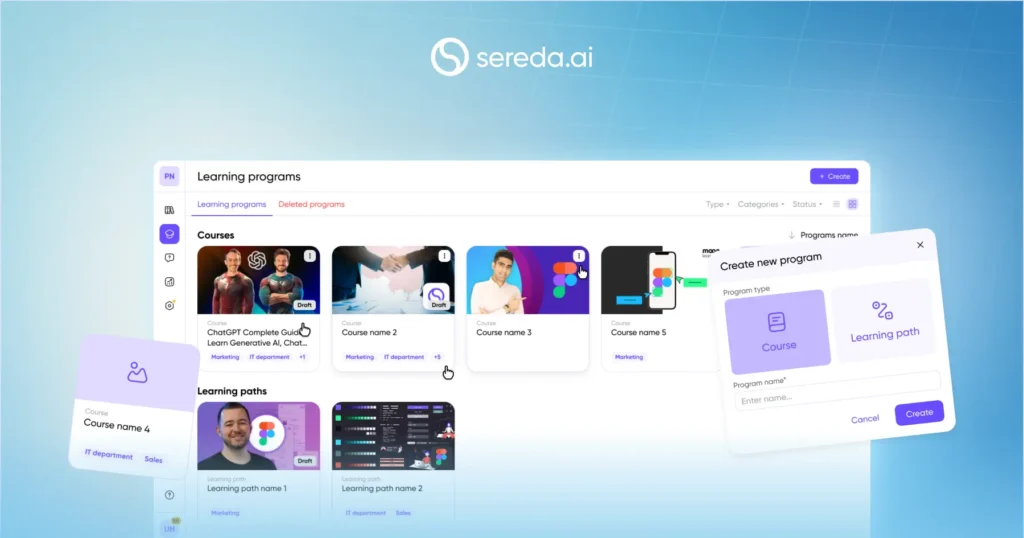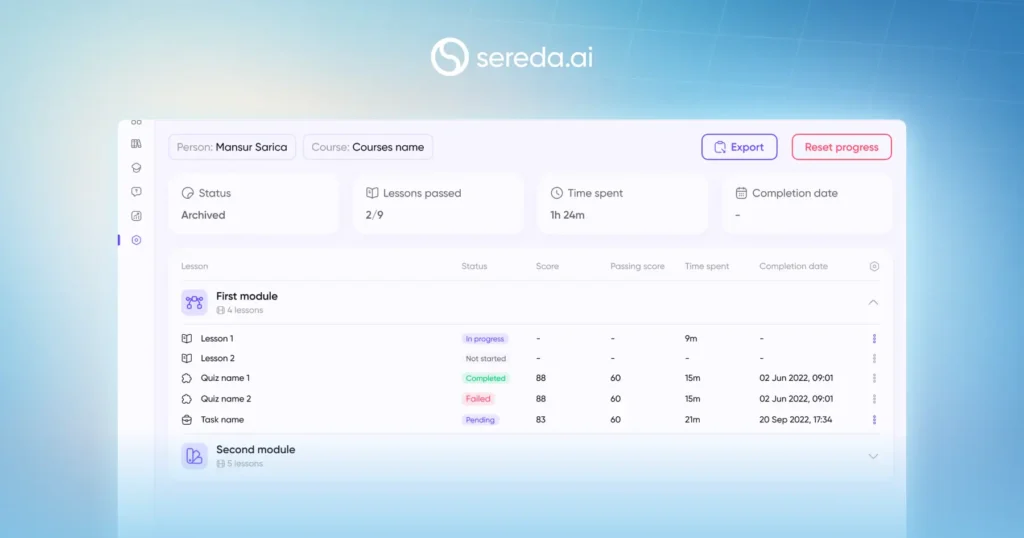Traditional employee learning systems often fall short due to time constraints and information overload. This is where corporate microlearning comes in – a modern, bite-sized approach to learning that enhances knowledge retention and engagement.
In this guide, the Sereda.ai team explores what is microlearning, its types, core benefits, and how organizations can implement it successfully.
So, What is Microlearning?
In the era of short-form content, microtraining will change your employee training for the better. Small and easy to digest – these are the main traits of corporate microlearning. In traditional education models, lessons can span up to an hour and cover various topics or one topic in extreme detail.
The study showed that most students watch short videos till the end and stay engaged, even up to 9 minutes. But after 12 minutes, interest drops fast, with only about 20% finishing. Hence, microlearning offers small educational pieces (videos, articles, emails etc.) that explore the topic with precision and deliver the information in 3 to 6 minutes.
Microlearning Types and Purposes
Now, what corporate microlearning types are there, and how can they help your employees learn faster and more effectively?
- Video microlearning: this is all about short (1-5 minutes) and punchy videos, that are usually created in clusters to teach a specific concept or a skill. This type of content is highly engaging and is ultimately your go-to microtraining format.
- Gamified microlearning: if you want your employees to be engaged and actively interact with your learning programs, then gamified microlearning is for you. This content usually comes in quizzes, reward-based games, knowledge challenges, etc.
- Text-based microlearning: some students process written information much better than animated content. For that purpose, email digests, flashcards, and quick reference guides will work great as part of core education for your students.
- Interactive microlearning: if your employee needs hands-on practice, that interactive model is your perfect solution. This content operates in the form of simulations, scenario-based decision-making modules, and chatbot-driven learning interactions.

5 Core Benefits of Microlearning
Apart from its structure and short form, how can microtraining benefit your company in particular? Let’s take a closer look:
1. Learner-centric
If your employee understands visual content better than written, or they prefer simple text on screen – microlearning will get them covered. This method of employee learning is specifically tailored to different learner needs, it can be adjusted and available at any time – which makes it perfectly learner-centric.
2. Faster to deliver
Because microtraining consists of short, focused lessons, it’s quicker to create and implement compared to traditional training programs. This makes it ideal for organizations that need to launch training initiatives fast, especially when addressing urgent learning needs.
3. Higher engagement
Another study found that students who watched short videos (~8 minutes) were 24.7% more engaged and scored better marks on exams than those who sat through long lectures. This shows that bite-sized content keeps learners interested and improves retention – making microlearning an effective choice for employee training.
4. Affordable and agile
Corporate microlearning is proven to be cost-effective: it reduces content development time and minimizes the need for expensive in-person training sessions. Also, this method of learning allows for rapid updates and modifications to training materials.
5. Less time-consuming
Finally, this is a great way to combine a tight schedule with ongoing employee training. Whether it’s a short video or a quick quiz, learning can happen in between tasks, during breaks, or even on mobile devices.
How to Develop Microlearning Strategy for Your Organization?
As with any type of employee training, microlearning needs a solid plan to fit in smoothly. Here are five key steps to make it work:
Step 1. Fit your use case
Does this type of training align with your business goals? Here’s why this is important: even though microtraining is effective, depending on the industry, some companies cannot afford to have simplified education and they need extensive long-form training.
Step 2. Choose the right microlearning format
As we explored before, different formats serve various purposes, so establishing what kind of training your industry and team demand is crucial. You can go as far as launching an employee survey to understand your student’s needs better.
Step 3. Develop engaging content
Invest in quality content creation, that will stick with your employees. For this, storytelling, visuals, real-life examples, and gamification will do wonders to increase engagement and retention.
Step 4. Measure effectiveness & optimize
As always, it’s crucial to track learner progress to evaluate the impact of microlearning and find areas of improvement. Here Learning Management System (LMS) can be a great help by providing powerful analytics and insights to spot trends in learner behavior and optimize your strategy.
Step 5. Choose the best tools
Finally, no strategy is complete without a toolkit! Microlearning apps are your go-to tools for effective education development. You can choose apps like Headway that create products specifically for microtraining. On the other hand, if you’re aiming for more advanced tools, that will help you create more complex educational cycles, then LMS systems will be a great pick for you.
Read also: What is LMS: Types, Features, and Benefits of Learning Management Systems

Corporate microlearning with Sereda.ai
Sereda.ai makes employee training effortless with AI-powered learning. Our LMS platform helps companies speed up onboarding, skill development, and adaptation – so your team can learn faster and work smarter.
Here’s how Sereda.ai will supercharge your corporate microlearning:
- Unlimited courses: feel free to create as many different courses as possible! Onboarding, adaptation, or fine-tuning employee qualification – with our tool you can do it all without a limit.
- Learning path: microlearning works best in clusters. With our platform, you can create a series of courses that will gradually open to employees as they progress.
- AI assistant: Sereda.ai acts as a personal mentor for your employees. Our AI assistant answers questions, pulls relevant information from learning materials, and streamlines the learning process. This not only saves time but also allows employees to learn independently without relying on senior colleagues for guidance.
- Integration with messengers: our AI bot can be integrated with Telegram, so your employee can get access to his virtual mentor anytime and from any device.
- Analytics: if you want to check how employees are progressing with their learning – our platform can provide you with a comprehensive real-time report with in-depth learning analytics.
- Testing and examination: Our platform allows you to create tests after each module and perform final examinations to analyze the material’s comprehension. With Sereda.ai you can also create custom certificates that will be given to your students after successfully completing exams.
By automating key training processes, Sereda.ai frees up time, boosts efficiency, and keeps your business running smoothly!
Conclusion
Microlearning is revolutionizing corporate training by making learning more engaging, accessible, and effective. By delivering short, focused content tailored to employees’ needs, businesses can foster continuous skill development without disrupting workflows.
Want to see how Sereda.ai can help your team embrace corporate microlearning? Request a demo call with our growth managers today and discover how AI-driven training can transform your organization!